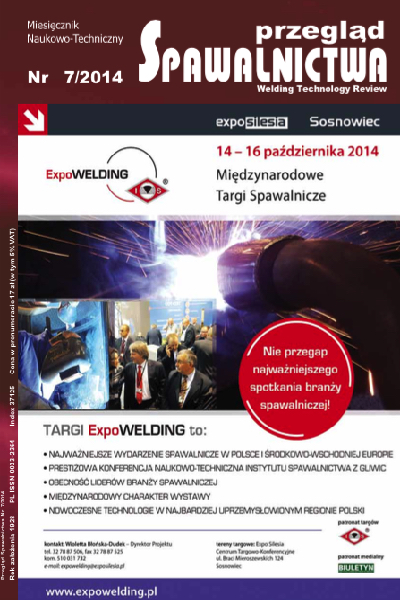Porównanie cięcia laserowego z cięciem strumieniem wodno-ściernym; The comparison of a laser cutting with a water-abrasive stream cutting
Main Article Content
Abstract
Omówiono podstawy fizyczne procesu cięcia laserowego i cięcia strumieniem wodno-ściernym. Przedstawiono budowę urządzenia do cięcia laserowego i urządzenia do cięcia strumieniem wodno-ściernym. Omówiono zagadnienia dotyczące jakości powierzchni cięcia. Zestawiono wyniki oceny jakości powierzchni cięcia wybranych elementów o różnej grubości dla cięcia laserowego i cięcia strumieniem wodno-ściernym. Porównano koszty i efekty ekonomiczne stosowania obu metod cięcia. Całość zakończono wnioskami dotyczącymi możliwości technicznych i opłacalności ekonomicznej stosowania omawianych metod cięcia.
Abstract
The physical bases of a laser cutting process and water-abrasive jet cutting were described. A structure of a laser cutting machine and water-abrasive jet cutting machine was depicted. The issues referring to the qual- ity of a surface of a cut were shown. The results of an assessment of a surface quality of particular elements of different thickness for the laser cutting and water-abrasive jet cutting were compared. The costs and economical effects of both ways of cutting were also compared. The article was summarised by the conclusions relating to the technical capabilities and economical cost-effectiveness of a usage of the described methods.
Downloads
Article Details
Creative Commons CC BY 4.0 https://creativecommons.org/licenses/by/4.0/
Welding Technology Review (WTR) articles are published open access under a CC BY licence (Creative Commons Attribution 4.0 International licence). The CC BY licence is the most open licence available and considered the industry 'gold standard' for open access; it is also preferred by many funders. This licence allows readers to copy and redistribute the material in any medium or format, and to alter, transform, or build upon the material, including for commercial use, providing the original author is credited.
References
Aichele G., Nickenig L.: Laserstrahlschneiden Laserprinzip Und Arbeitweisen gebrauchlicher Schneidlaser. Der Praktiker, 2013, t. 55, nr 8, s. 230-235.
Chaskin V. Ju., Lukasenko A.G.: Cięcie korpusów pił tarczowych z zastosowaniem wiązki lasera CO2. Avtomat. Svarka. 2005, nr 2, s. 47-49.
Vanschen W.: Vom autogen Brennschneiden bis zum Elektronenstrahlbohren Laserstrahlschweissen. Praktiker Schweissen und Schneiden. 1994, t. 46, nr 5, s. 236-246.
Franke J., Schulz W, Herzinger G: Abbrandstabilisiertes Laserstrahlbrennschneiden ein neues Verfahren. Schweissen und Schneiden. 1993, t. 45, nr 9, s. 490-493.
Mirski Z., Granat K., Sapijaszko G.: Cięcie laserem moleku- larnym CO2 blach elektrotechnicznych. Przegląd Spawalnictwa. 2003, nr 8-10, s. 139-141.
Andersen C.B.: Abrasive water jet cutting at how water pressure. Applications in the offshore industry. Riv. Ital. 1993, nr 2, s. 151-154.
Louis H., Pude F., Rad C. i in.: Abrasive water suspension jet technology fundamentals, application and developments. Weld. World. 2007, t. 51, nr 9-10, s. 11-16.
